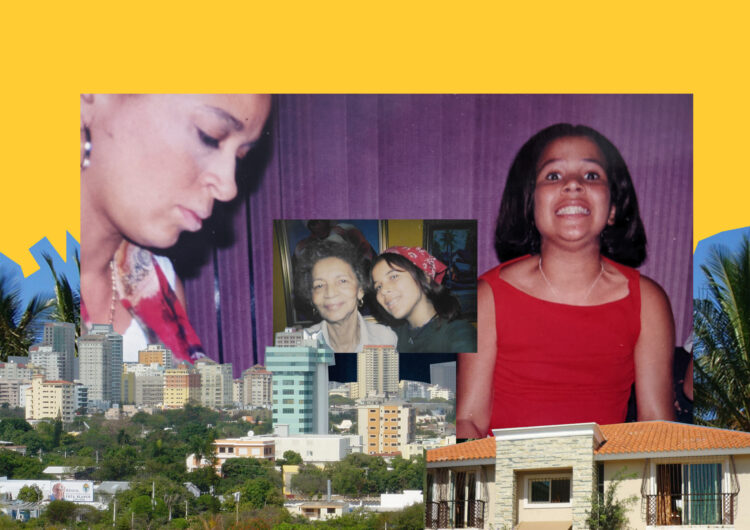As I scroll past images of wallpapers for the new apartment, I suddenly remember how much I loved the colors of my godmother’s house in Constanza. I am taken back to 1999, and remember my mom telling me how she was going to paint my room just like that: blue and yellow, with a wash technique. She combined the colors to match el juego de sábanas she got me in Miami, one that I keep in my childhood closet in la Rosa Duarte ‘til this day.
I remember the care: this was about me. I don’t have that many memories where I felt my mom was doing something completely for me and about me. I was a prop, a card to flash and use in her one-woman show: the reason to skip meetings, to not answer calls, her reason for being late. I heard so many times my mom lying about me being sick, and in the same breath, saying how wrong it is to lie. This was around the first time I might’ve been depressed.
I was 11 and I didn’t like my new school. I was bullied into believing I was unlovable: Not good enough, not thin enough, not rich enough, not femme enough. I was not another blonde-haired girl, nor did my family have membership at any of the city’s clubs. I couldn’t concentrate in class if I wasn’t allowed to doodle, nor did I understood that Ferragamo was a brand of shoes and not a chocolate. This school was about my mother—a wannabe socialite, but too much in debt, too addicted, too narcissistic, and down a whirlwind of decay. The weight of her last name, and of wanting to buy into whiteness in this colonial nightmare of a country, pushed her to use me again, buying into the spheres of Dominican upper class with her queer little girl. She forgot she was basically a bastard child and that these people know how to distinguish them from the crowd.
Being 11, bullied, and feeling out of place, I was suggested to go to the therapy by the school psychologists: “Gina no está bien”. This was the first time these school folks decided to intervene in a long line of school interventions. This was around the same time where I spent days at school waiting for my mom to come; she was, as always, too late. My after-school sessions included someone ordering food for me while I waited alongside school workers. I wasn’t in any class or activity, yet I was the last kid to leave. With this I remember the missed functions, the constant headaches, the constant anxiety.
In that school, I was too much of a bad influence because I dared to question people and stand up for any nonsense I was subjected to. My mom didn’t see that her kid was too wide-nosed, too ignorant of upper-class societal norms, and too unwilling to sit down with her legs crossed. I remember telling my mom I was going to fail my classes if I didn’t get changed from that school. My mom ensured I could move to the school I wanted once the year came to an end. Was this about me? Was this because of my love for her, or was I shaming her for not fitting in? I do remember being invited to leave: “This is not a good fit for your kid” the principal said while looking at my dirty shoes at the end of my spread-out legs.
What did that psychologist say about me? I used to draw on those sessions all the time and remember taking so many tests. I didn’t understand half of what was going on. She was an old white lady who smelled like roses. Therapy was in an old apartment building in la Lincoln, and Mom would come by, late again, to pick me up; the psychologist always looked concerned. The last thing I remember was the psychologist suggesting painting classes; I never got them and resented this for many years. I don’t think I ever ended my treatment properly. Whenever I asked about the activities I stopped doing as a kid, a lot of the answers involved money: “¿Y con qué se iba a pagar?” my dad would answer frustrated. I think about the white lady, the apartment, and mental health in DR, and I just say to myself, “Eso sí e caro.”
But the tardiness, dio’ mio. My grandmother once poked fun at my mom when she picked us up late and had two bags of McDonald’s for me and my brother: “You think you’re gringos just eating McDonald’s all the time”. I agreed—why the fuck did we eat that trash? People used to love whenever their parents would get them McDonald’s, back home it was a treat. I hated McDonald’s. It meant I was left behind, again, and had to feel shame, again, for my mom… because of my mom.
Today I was talking about my mom. I haven’t spoken to her for a while. You see, in the process of growing in love—with myself, that is—I’ve had to learn about some boundaries to love in a way that protects and cherishes me. It has been a wild ride, one that has taken over 20 years to be where I stand. One that has taken me through a lot of clashes with my sense of self and belonging, recognizing what I can’t change or handle, and understanding where that Gina stood and continued to walk towards. What was I carrying that wasn’t mine? What belonged to the inheritance of those closer to whiteness in an island with colonial lethargy? What belonged to the internal shame of my family’s Blackness and lack of funds, that could be read through the light eyed-itis in el infierno de Guzmán? I wonder how my mom is.
Wallpaper.
I want a yellow wallpaper that matches the walls of my home in the photo I keep of my abuelita and me. I used to hate yellow for years. Now yellow reminds me of abuelita’s love, of the patience I have to hold, for myself and for others. Yellow reminds me of the brightness of the Caribbean noon, of dirty shoes, and an alternative childhood I hope for other queer kids: a safe and fulfilling one.
Gina Goico (born 1989, Dominican Republic/The Bronx) is a multidisciplinary artist, educator, and self-proclaimed necia. Through their work, Goico navigates their identity and the spaces where they exist in the Dominican Republic and the United States. Through their career, they have come to create a diverse body of work that ranges from embroidery to installations, ink drawings, and performance. Goico also facilitates spaces for temporary communities and dialogues around healing in the current status quo.
Goico was a Van Lier Fellow and artist in residence with Smack Mellon. They also participated in AIM fellowship at The Bronx Museum of the Arts, The Laundromat Project, Kelly Street Resident Artist, among others. They have exhibited in the US and the DR, and continue to support actively socio-political initiatives in the island and in diaspora. Goico holds an AAS in Fine Arts and Illustration from Altos de Chavon the School of Design in the Dominican Republic and a BFA in Fine Arts from Parsons. They are expected to graduate from a MA in Arts Politics from NYU in 2021. Follow them here: ginagoico.com, @ginamgoico, @ginagoico.






